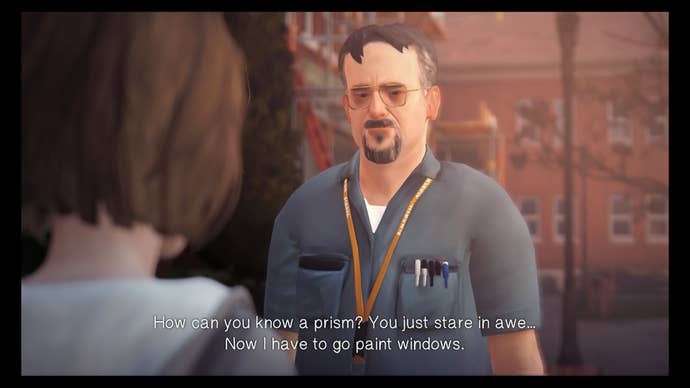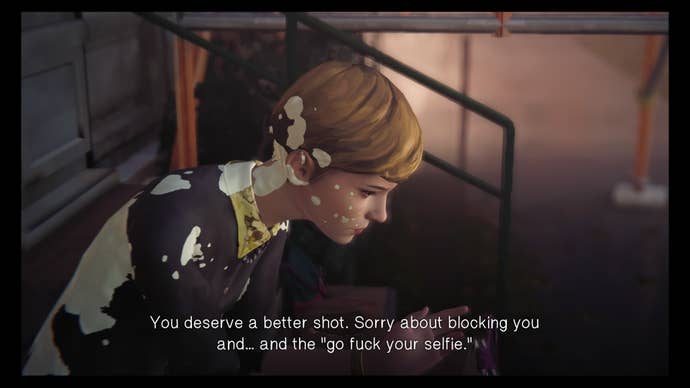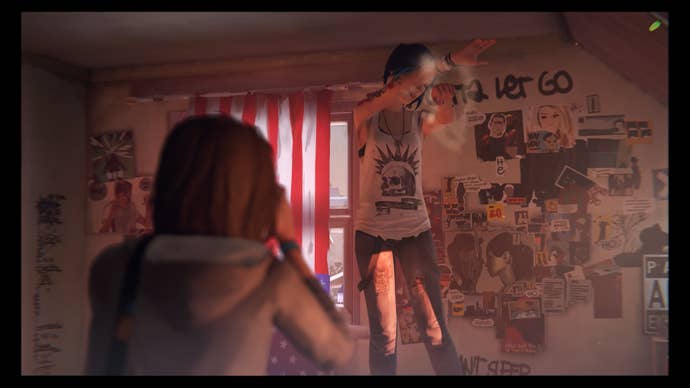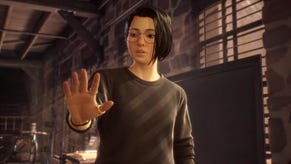Life is Strange, Episode 1 PS4 Review: Be Kind, Rewind
Dontnod's time-bending episodic series takes its first, uneasy steps into new territory.
This article first appeared on USgamer, a partner publication of VG247. Some content, such as this article, has been migrated to VG247 for posterity after USgamer's closure - but it has not been edited or further vetted by the VG247 team.
What would you give to go back in time and correct your actions? To be able to jump back over and over again to find the right answer, to make the perfect first impression, or to let out your true feelings about the tiny transgressions we all ignore each day. What would you do then? Who would you be?
Life is Strange is about these questions. Protagonist Max Caulfield - a slight reference to Catcher in the Rye's rebellious Holden Caulfield? - is an aspiring 18 year old photographer who has been officially accepted into the prestigious Blackwell Academy in her hometown of Arcadia Bay. After a few years away in Seattle, Max now has to return to Oregon. New kid, new school; the hunt for social acceptance. The benefit of this framing is that Max not only has to meet the wholly-new inhabitants of Blackwell Academy, but there's also re-kindling the relationships she left behind, like her former best friend, Chloe.

Into this story of homecoming, developer Dontnod throws in a supernatural twist: Max begins the story near Arcadia Bay's lighthouse in the midst of a huge hurricane, before waking up in her photography class. She later witnesses a murder, only to wake up in her class again. It's here that Max begins to explore her time-bending powers and the game lays down the ground rules: Max can rewind time in short bursts, but she retains the knowledge, items, and positioning from previous loops. (Except for points in the story where she doesn't? Dontnod breaks the rules occasionally.) She can rewind time as many times as she wants, but her limits seem to be locally-based; once she leaves an area, she can't go back.
Life is Strange is an episodic adventure game in the Telltale style, with the heroine walking around discrete areas talking to people and making decisions. Think of Max's power as a version of what players normally do in Telltale's titles. Instead of saving and reloading to see where other options take you, you can see Max's alternate paths within the game itself. It's a cool idea and it manifests itself in interesting ways: Max discovers one character's stash of surveillance footage, but in doing so, she drops the files in some oil. No problem; just read the oil-soaked files and rewind to before she went snooping. She keeps the knowledge and the character has no clue they've been found out.

Max's power is a benefit from a character perspective. There's a decent supporting cast in Blackwell Academy, where Episode 1 mostly takes place, but your encounters with them seem largely optional outside of a few key characters. Time loops mean you get to converse with them in multiple ways, teasing out new information and new facets of their lives. Victoria is the Queen of the school for example, but judicious rewinding shows you that while she can be very mean to Max, they can also find some common understanding.
The rewind also creates a bit of distance between you and Max, because Max is just Max. In Telltale titles, you're very cognizant of playing your Lee, your Bigby, or your Clementine. Even the reactions of their supporting casts are based largely on your decisions. Here, the rewind time power means you see all the alternatives; I doubt anyone is going to play Life is Strange without seeing every option during a playthrough. This makes it feel like the player is looking into Max's life; Max is Max, and supporting cast is still whoever they are. This is mirrored in some of the choices you can't make: when a friend gives Max a flash drive that happens to have her name on a folder, you're not given the option to dig deeper, ostensibly because Max herself would never think to dig deeper. It's frustrating, but also serves to establish who Max is.


Wandering around talking to students and solving limited time-based puzzles isn't much of a hook - even the impending hurricane doesn't seem like that much of a pressing issue - so Dontnod has thrown in a bit of a thriller action. Prior to Max joining the Blackwell Academy, popular student Rachel Amber went missing. Posters litter every area Max walks through, so she's meant to constantly be on your mind. Everyone at Blackwell knew Rachel, everyone has an opinion on where she went, and oddly enough, most of the supporting cast has a slight motive for her disappearance. It constantly has you asking questions: Who took Rachel, or did she just leave? What does this have to do with the school's elite Vortex Club? Does this person have a proper motive for the crime? It's enough to fuel pages upon pages of forum speculation, I'm sure.
Life is Strange looks good in screenshots, but the game's presentation does stumble a bit. The lip-syncing is awful; the game looks enough like a Telltale game that the bad lip-syncing makes you realize how much work good lip-syncing really requires. The environments themselves looked lived in, but this draws your attention to details like the fact that no one's medium-length hair moves when they move or the occasional blurry texture. Finally, the dialog is cringe-worthy at times, feeling like an adult's version of what teenagers actually sound like. (I'll allow for the idea that I'm wrong and I don't know what teenagers sound like.) The dialog just feels cheesy and over-wrought at times.

Despite all these stumbles, the largest problem is Life is Strange Episode 1 is just the beginning. It's all establishing, showing us Max, her powers, Chloe, and the rest of the supporting cast. You never get enough meat to really buy into the concept, which lacks the licensed tie-in of Game of Thrones and A Wolf Among Us, or the immediacy of The Walking Dead's setting. The hurricane is a few days away, but Max is the only one who knows about it for most of the game. Rachel is missing, but you only have her story through second-hand perceptions. That's something that the devs at Dontnod can correct in later episodes, but the real hook is not on display here. I'm intrigued, but I haven't bought into Life is Strange completely yet.
VisualsLife is Strange looks pretty good, but the lip-syncing is awful. There's also the occasional detail that looks off, like blurry textures.
SoundThe game's score is composed by Syd Matters' Jonathan Morali, with music from some alternative acts.
InterfaceThe interface really does feel like a teenager's sketchbook.
Lasting AppealThe rewind mechanic means you'll experience most of the episode in one playthrough. Not much more to see beyond that.
ConclusionLife is Strange is an episodic adventure in the Telltale-style, placing you in the shoes of 18 year old Max Caulfield. Max can rewind time at will and has prophetic dreams of the future. Episode 1 is all intro, giving you a look at Max's powers and her supporting cast, but not much else. There's hints of bigger things on the horizon, but neither issue is immediate within Episode 1. I'm intrigued, but Episode 2 needs to give me a stronger reason to finish all five episodes.

















